How can I write colored text to the console with C++? That is, how can I write different text with different colors?
-
Did but no resources to find *different colors in the C++ console* :) – Sudantha Oct 29 '10 at 16:24
-
6What's the C++ console?? – Edward Strange Oct 29 '10 at 16:30
-
Possible duplicate of: http://stackoverflow.com/questions/3585846/color-text-in-terminal-aplications-in-unix – karlphillip Oct 29 '10 at 16:38
-
Be careful of these answers. Your console will have the changes after the program exits if you don't revert them yourself. – kayleeFrye_onDeck Jul 11 '17 at 19:21
15 Answers
Add a little Color to your Console Text
HANDLE hConsole = GetStdHandle(STD_OUTPUT_HANDLE);
// you can loop k higher to see more color choices
for(int k = 1; k < 255; k++)
{
// pick the colorattribute k you want
SetConsoleTextAttribute(hConsole, k);
cout << k << " I want to be nice today!" << endl;
}

Character Attributes Here is how the "k" value be interpreted.
- 3,333
- 5
- 26
- 46
-
85
-
2
-
4
-
3
-
4
-
2
-
2@KiraSama Use GetConsoleScreenBufferInfo() API to get current value of CONSOLE_SCREEN_BUFFER_INFO, and its member wAttributes will have the current colour info. – Sheen May 11 '18 at 22:18
-
1@XStylish void WriteInColor(int color, string text) { HANDLE hConsole = GetStdHandle(STD_OUTPUT_HANDLE); CONSOLE_SCREEN_BUFFER_INFO cbInfo; GetConsoleScreenBufferInfo(hConsole, &cbInfo); int originalColor = cbInfo.wAttributes; SetConsoleTextAttribute(hConsole, color); cout << text; SetConsoleTextAttribute(hConsole, originalColor); } – user875234 Oct 04 '18 at 15:26
-
@user875234 I already solved my problem, so I didn't test your code but it's clearly wrong, you're getting the *current* color which is the original color at the **1st-time-only** storing it temporarily. After the function ends, it'd disappear so if we changed the console to a custom color after then, the `WriteInColor` function becomes useless. You should test `if you didn't get the original color yet`, if true, store it in a **global** variable, so whenever we use the `WriteInColor` function, if wanted to set it back to default, we can use the global variable we created at the 1st-parameter. – Beyondo Oct 05 '18 at 08:01
-
1It sets the color back at the end of the function. I figured you had it figured out by now. I was just posting in case someone had the same problem as you and me. – user875234 Oct 05 '18 at 11:39
-
-
1Seems you can use shorthand `SetConsoleTextAttribute( GetStdHandle(-11) , 0x08);` – Danilo Sep 09 '19 at 23:44
-
ANSI escape color codes :
Name FG BG
Black 30 40
Red 31 41
Green 32 42
Yellow 33 43
Blue 34 44
Magenta 35 45
Cyan 36 46
White 37 47
Bright Black 90 100
Bright Red 91 101
Bright Green 92 102
Bright Yellow 93 103
Bright Blue 94 104
Bright Magenta 95 105
Bright Cyan 96 106
Bright White 97 107
Sample code for C/C++ :
#include <iostream>
#include <string>
int main(int argc, char ** argv){
printf("\n");
printf("\x1B[31mTexting\033[0m\t\t");
printf("\x1B[32mTexting\033[0m\t\t");
printf("\x1B[33mTexting\033[0m\t\t");
printf("\x1B[34mTexting\033[0m\t\t");
printf("\x1B[35mTexting\033[0m\n");
printf("\x1B[36mTexting\033[0m\t\t");
printf("\x1B[36mTexting\033[0m\t\t");
printf("\x1B[36mTexting\033[0m\t\t");
printf("\x1B[37mTexting\033[0m\t\t");
printf("\x1B[93mTexting\033[0m\n");
printf("\033[3;42;30mTexting\033[0m\t\t");
printf("\033[3;43;30mTexting\033[0m\t\t");
printf("\033[3;44;30mTexting\033[0m\t\t");
printf("\033[3;104;30mTexting\033[0m\t\t");
printf("\033[3;100;30mTexting\033[0m\n");
printf("\033[3;47;35mTexting\033[0m\t\t");
printf("\033[2;47;35mTexting\033[0m\t\t");
printf("\033[1;47;35mTexting\033[0m\t\t");
printf("\t\t");
printf("\n");
return 0;
}
GCC :
g++ cpp_interactive_terminal.cpp -o cpp_interactive_terminal.cgi
chmod +x cpp_interactive_terminal.cgi
./cpp_interactive_terminal.cgi
- 3
- 4
- 1,030
- 6
- 11
-
14@Mehdi Mohammadpour I have Windows 10, and your escape codes *are* working for me, but it appears to me that you've got the Foreground and Background codes reversed. Can you please reverse the headings 'FG' and 'BG' please? – yamex5 Mar 20 '19 at 01:32
-
-
-
1
-
4Espace sequences are basically for Linux. This will mostly not work with Windows – Felierix Mar 06 '22 at 16:50
-
1In windows, you might need to enable the Virtual Terminal mode to use those color codes, checkout https://learn.microsoft.com/en-us/windows/console/console-virtual-terminal-sequences#example-of-enabling-virtual-terminal-processing – EdgeNeko Dec 01 '22 at 16:42
Standard C++ has no notion of 'colors'. So what you are asking depends on the operating system.
For Windows, you can check out the SetConsoleTextAttribute function.
On *nix, you have to use the ANSI escape sequences.
- 126,773
- 69
- 172
- 181
-
6Note that ASNI sequences (or at least some of them) work on Windows' CMD.EXE as well. – Nic May 04 '16 at 18:26
-
4@Asu, they don't before Win10 Anniversary Edition. If your Win10 us up-to-date, you have it. – kayleeFrye_onDeck Jul 11 '17 at 18:30
I've found header-only open-source C++ library working on multiple platforms: https://github.com/imfl/color-console
Color Console:
A lightweight header-only C++ library to bring colors to your Windows console with a very-easy-to-use API that frees you from the burden of setting and resetting screen colors every time you make a call.
#include "../include/color.hpp" #include <iostream> int main() { std::cout << dye::aqua("Hello, World!") << std::endl; return 0; }
You are seeing Hello, World! in aqua.
No need to reset: most solutions on the market work like manipulators, which constantly require you to reset the screen color after you set it. While this traditional approach is also offered in this library in the hue namespace ...
tabulate:
If You want not only to change colors but print text in more readable form (e.g. in form of tabular) it is also https://github.com/p-ranav/tabulate which can change colors and draw tables in console.
tabulate is a header-only library. Just add include/ to your include_directories and you should be good to go. A single header file version is also available in single_include/. NOTE Tabulate supports >=C++11.
-
1These are both very good. thanks a lot. the bad thing though is the first one is windows specific only. – Hossein Apr 06 '21 at 07:59
-
4Last two days I've found better multi-platform library for colors: https://github.com/jupyter-xeus/cpp-terminal It is being developed by Jupyter-xeus - people from CERN. – baziorek Apr 06 '21 at 08:51
You can write methods and call like this
HANDLE hConsole;
hConsole = GetStdHandle(STD_OUTPUT_HANDLE);
int col=12;
// color your text in Windows console mode
// colors are 0=black 1=blue 2=green and so on to 15=white
// colorattribute = foreground + background * 16
// to get red text on yellow use 4 + 14*16 = 228
// light red on yellow would be 12 + 14*16 = 236
FlushConsoleInputBuffer(hConsole);
SetConsoleTextAttribute(hConsole, col);
cout << "Color Text";
SetConsoleTextAttribute(hConsole, 15); //set back to black background and white text
-
4Note that `SetConsoleTextAttribute(hConsole, 15);` sets color to *Bright White*, not to *White*. ***7 - White.*** and ***15 - Bright White*** – GooDeeJAY Apr 28 '20 at 03:45
On Windows 10 you may use escape sequences this way:
#ifdef _WIN32
SetConsoleMode(GetStdHandle(STD_OUTPUT_HANDLE), ENABLE_VIRTUAL_TERMINAL_PROCESSING);
#endif
// print in red and restore colors default
std::cout << "\033[32m" << "Error!" << "\033[0m" << std::endl;
- 351
- 5
- 11
-
`ENABLE_VIRTUAL_TERMINAL_PROCESSING` somehow does not work for me on Windows 10. I get `[32mError – Cem Polat Jun 03 '22 at 11:00
-
The simplest way you can do is:
#include <stdlib.h>
system("Color F3");
Where "F" is the code for the background color and 3 is the code for the text color.
Mess around with it to see other color combinations:
system("Color 1A");
std::cout << "Hello, what is your name?" << std::endl;
system("Color 3B");
std::cout << "Hello, what is your name?" << std::endl;
system("Color 4c");
std::cout << "Hello, what is your name?" << std::endl;
Note: I only tested on Windows. Works. As pointed out, this is not cross-platform, it will not work on Linux systems.
- 5,600
- 2
- 36
- 44
-
5This is a bad approach! Code is not cross-platform, it will not work in Linux systems – GooDeeJAY Apr 28 '20 at 03:40
-
1Not only that, you're also invoking system commands. This is terribly inefficient. – Noud Zandbergen Dec 25 '20 at 10:16
Here is my solution that is lightweight and works with both Windows and Linux:
#include <iostream>
#include <string>
#ifdef _WIN32
#define WIN32_LEAN_AND_MEAN
#define VC_EXTRALEAN
#include <Windows.h> // for displaying colors
#endif // Windows
using namespace std;
#define color_black 0
#define color_dark_blue 1
#define color_dark_green 2
#define color_light_blue 3
#define color_dark_red 4
#define color_magenta 5
#define color_orange 6
#define color_light_gray 7
#define color_gray 8
#define color_blue 9
#define color_green 10
#define color_cyan 11
#define color_red 12
#define color_pink 13
#define color_yellow 14
#define color_white 15
string get_textcolor_code(const int textcolor) { // Linux only
switch(textcolor) {
case 0: return "30"; // color_black 0
case 1: return "34"; // color_dark_blue 1
case 2: return "32"; // color_dark_green 2
case 3: return "36"; // color_light_blue 3
case 4: return "31"; // color_dark_red 4
case 5: return "35"; // color_magenta 5
case 6: return "33"; // color_orange 6
case 7: return "37"; // color_light_gray 7
case 8: return "90"; // color_gray 8
case 9: return "94"; // color_blue 9
case 10: return "92"; // color_green 10
case 11: return "96"; // color_cyan 11
case 12: return "91"; // color_red 12
case 13: return "95"; // color_pink 13
case 14: return "93"; // color_yellow 14
case 15: return "97"; // color_white 15
default: return "37";
}
}
string get_backgroundcolor_code(const int backgroundcolor) { // Linux only
switch(backgroundcolor) {
case 0: return "40"; // color_black 0
case 1: return "44"; // color_dark_blue 1
case 2: return "42"; // color_dark_green 2
case 3: return "46"; // color_light_blue 3
case 4: return "41"; // color_dark_red 4
case 5: return "45"; // color_magenta 5
case 6: return "43"; // color_orange 6
case 7: return "47"; // color_light_gray 7
case 8: return "100"; // color_gray 8
case 9: return "104"; // color_blue 9
case 10: return "102"; // color_green 10
case 11: return "106"; // color_cyan 11
case 12: return "101"; // color_red 12
case 13: return "105"; // color_pink 13
case 14: return "103"; // color_yellow 14
case 15: return "107"; // color_white 15
default: return "40";
}
}
string get_print_color(const int textcolor) { // Linux only
return "\033["+get_textcolor_code(textcolor)+"m";
}
string get_print_color(const int textcolor, const int backgroundcolor) { // Linux only
return "\033["+get_textcolor_code(textcolor)+";"+get_backgroundcolor_code(backgroundcolor)+"m";
}
void print_color(const int textcolor) {
#if defined(_WIN32)
static const HANDLE handle = GetStdHandle(STD_OUTPUT_HANDLE);
SetConsoleTextAttribute(handle, textcolor);
#elif defined(__linux__)
cout << get_print_color(textcolor);
#endif // Windows/Linux
}
void print_color(const int textcolor, const int backgroundcolor) {
#if defined(_WIN32)
static const HANDLE handle = GetStdHandle(STD_OUTPUT_HANDLE);
SetConsoleTextAttribute(handle, backgroundcolor<<4|textcolor);
#elif defined(__linux__)
cout << get_print_color(textcolor, backgroundcolor);
#endif // Windows/Linux
}
void print_color_reset() {
#if defined(_WIN32)
static const HANDLE handle = GetStdHandle(STD_OUTPUT_HANDLE);
SetConsoleTextAttribute(handle, 7); // reset color
#elif defined(__linux__)
cout << "\033[0m"; // reset color
#endif // Windows/Linux
}
void println(const string& s="") {
cout << s << endl;
}
void print(const string& s="") {
cout << s;
}
void print(const string& s, const int textcolor) {
print_color(textcolor);
cout << s;
print_color_reset();
}
void print(const string& s, const int textcolor, const int backgroundcolor) {
print_color(textcolor, backgroundcolor);
cout << s;
print_color_reset();
}
void print_no_reset(const string& s, const int textcolor) { // print with color, but don't reset color afterwards (faster)
print_color(textcolor);
cout << s;
}
void print_no_reset(const string& s, const int textcolor, const int backgroundcolor) { // print with color, but don't reset color afterwards (faster)
print_color(textcolor, backgroundcolor);
cout << s;
}
And here is an example how to use it:
int main() {
print("Hello ", color_red, color_blue);
print("World!\n", color_black, color_yellow);
println();
return 0;
}
- 4,535
- 2
- 14
- 34
-
1Hi, I've got a question. Am I right that `reset` color for Windows is just the `color_light_gray`, as far as you use `7` to reset color? – hazer_hazer Jun 11 '21 at 14:49
-
1@hazer_hazer yes exactly. Light gray text and black background is the default color for the Windows console. If you have set a different default color, you can make a global variable defaultcolor, initialize it in the beginning with GetConsoleTextAtteibute(handle, defaultcolor); and use that for print_color_reset();. The Linux variant in contrast always goes back to whatever you have set as default colors, not necessarily light gray on black. – ProjectPhysX Jun 12 '21 at 05:14
-
-
1@j0h there is an `#ifdef _WIN32 ... #endif` switch for the preprocessor. On Linux, `_WIN32` is not defined, so it does not include `
` on a Linux system. The `_WIN32` and `__linux__` defines are very useful as they allow for detecting on which operating system the code runs. – ProjectPhysX Jul 30 '21 at 06:04 -
1
You can use ANSI escape sequences to colorizing the console text, it works for windows and Linux. For Windows, you need to activate the virtual terminal.
#include <iostream>
#ifdef _WIN32
#include <windows.h>
#define ENABLE_VIRTUAL_TERMINAL_PROCESSING 0x0004
#define DISABLE_NEWLINE_AUTO_RETURN 0x0008
void activateVirtualTerminal()
{
HANDLE handleOut = GetStdHandle(STD_OUTPUT_HANDLE);
DWORD consoleMode;
GetConsoleMode( handleOut , &consoleMode);
consoleMode |= ENABLE_VIRTUAL_TERMINAL_PROCESSING;
consoleMode |= DISABLE_NEWLINE_AUTO_RETURN;
SetConsoleMode( handleOut , consoleMode );
}
#endif
using namespace std;
enum COLORS {
NC=-1,
BLACK,
RED,
GREEN,
YELLOW,
BLUE,
MAGENTA,
CYAN,
WHITE,
};
/**
* Colorize terminal colors ANSI escape sequences.
*
* @param font font color (-1 to 7), see COLORS enum
* @param back background color (-1 to 7), see COLORS enum
* @param style font style (1==bold, 4==underline)
**/
const char *colorize(int font, int back = -1, int style = -1) {
static char code[20];
if (font >= 0)
font += 30;
else
font = 0;
if (back >= 0)
back += 40;
else
back = 0;
if (back > 0 && style > 0) {
sprintf(code, "\033[%d;%d;%dm", font, back, style);
} else if (back > 0) {
sprintf(code, "\033[%d;%dm", font, back);
} else {
sprintf(code, "\033[%dm", font);
}
return code;
}
int main()
{
#ifdef _WIN32
activateVirtualTerminal();
#endif
cout << colorize(RED) << "trying red" << colorize(NC) << endl;
cout << colorize(RED, BLACK) << "red and black background" << colorize(NC) << endl;
cout << colorize(YELLOW, BLUE, 1) << "yellow blue bold" << colorize(NC) << endl;
cout << colorize(BLACK, WHITE) << "Black white" << colorize(NC) << endl;
cout << colorize(MAGENTA, CYAN) << "Magenta cyan" << colorize(NC) << endl;
return 1;
}
- 7,011
- 3
- 57
- 60
In Windows, you can use any combination of red green and blue on the foreground (text) and the background.
/* you can use these constants
FOREGROUND_BLUE
FOREGROUND_GREEN
FOREGROUND_RED
FOREGROUND_INTENSITY
BACKGROUND_BLUE
BACKGROUND_GREEN
BACKGROUND_RED
BACKGROUND_INTENSITY
*/
HANDLE hConsole = GetStdHandle(STD_OUTPUT_HANDLE);
SetConsoleTextAttribute(hConsole, FOREGROUND_BLUE | FOREGROUND_GREEN | FOREGROUND_INTENSITY);
std::cout << "I'm cyan! Who are you?" << std::endl;
- 8,391
- 5
- 34
- 53
Assuming you're talking about a Windows console window, look up the console functions in the MSDN Library documentation.
Otherwise, or more generally, it depends on the console. Colors are not supported by the C++ library. But a library for console handling may/will support colors. E.g. google "ncurses colors".
For connected serial terminals and terminal emulators you can control things by outputting "escape sequences". These typically start with ASCII 27 (the escape character in ASCII). There is an ANSI standard and a lot of custom schemes.
- 4,481
- 12
- 45
- 84
- 142,714
- 15
- 209
- 331
-
Since that answer was written, Windows 10 gained support for ANSI escape sequences for the narrow console streams. – Cheers and hth. - Alf Oct 03 '16 at 18:27
I'm not sure what you really want to do, but my guess is you want your C++ program to output colored text in the console, right ? Don't know about Windows, but on all Unices (including Mac OS X), you'd simply use ANSI escape sequences for that.
- 90,870
- 19
- 190
- 224
Do not use "system("Color …")" if you don't want the entire screen to be filled up with color. This is the script needed to make colored text:
#include <iostream>
#include <windows.h>
int main()
{
const WORD colors[] =
{
0x1A, 0x2B, 0x3C, 0x4D, 0x5E, 0x6F,
0xA1, 0xB2, 0xC3, 0xD4, 0xE5, 0xF6
};
HANDLE hstdin = GetStdHandle(STD_INPUT_HANDLE);
HANDLE hstdout = GetStdHandle(STD_OUTPUT_HANDLE);
WORD index = 0;
SetConsoleTextAttribute(hstdout, colors[index]);
std::cout << "Hello world" << std::endl;
FlushConsoleInputBuffer(hstdin);
return 0;
}
You don't need to use any library. Just only write system("color 4f");
- 9
- 1
-
8This is windows only, and IIRC this will just make the entire screen one color – nathanfranke Apr 20 '20 at 00:52



